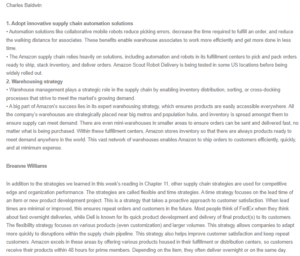Customer Satisfaction and Warehouse Management
Hello Breanne,
I agree that the time strategy takes a proactive approach to customer satisfaction. One main factor influencing customer satisfaction is the timely delivery of goods and services. Therefore, a company that can deliver goods and services within the shortest time after a customer places an order is likely to develop customer loyalty due to high customer satisfaction. Many companies have embraced the same-day- delivery option to create a competitive advantage. According to Rabello de Castro (2019), same-day delivery helps organizations build trust by guaranteeing professionalism and dependability. Therefore, companies with same-day delivery can establish long-term business relationships with their customers, thus creating competitiveness. Same-day delivery also helps companies increase revenue per order by setting higher fees for same-day delivery. This can significantly increase profit margins because customers are willing to pay more to quickly get the products and services they order.
References
Rabello de Castro, V. (2019). The value of same-day delivery. SSRN Electronic Journal. https://doi.org/10.2139/ssrn.3323536
Responding to Charles Baldwin
Hello Charles,
I agree that warehouse management plays a vital role in the supply chain by enabling sorting, inventory distribution, or cross-docking processes that focus on meeting market demand. Therefore, companies need to invest in proper warehouse management to enhance the efficiency of their supply chains. Elevli & Dinler (2021) state adequate warehouse management includes scheduling labor, receiving and organizing warehouse space, fulfilling orders, and managing inventory. The main benefits of a sound warehouse management system include high return on investment, high company productivity, customer service, and tracking and inventory control and management. A good warehouse management system should also be easily integrated with an organization’s business management systems. Organizations can enhance the efficiency of their warehouse management by using technology such as automation and robotics. These technologies reduce errors and increase the speed at which warehouse activities are completed.
References
Elevli, B., & Dinler, A. (2021). Multi-criteria approach for inventory classification and effective warehouse management. International Journal of Logistics Systems and Management, 1(1), 1. https://doi.org/10.1504/ijlsm.2021.10038601
ORDER A PLAGIARISM-FREE PAPER HERE
We’ll write everything from scratch
Question 

Customer Satisfaction and Warehouse Management
Charles Baldwin
1. Adopt innovative supply chain automation solutions
• Automation solutions like collaborative mobile robots reduce picking errors, decrease the time required to fulfill an order, and reduce the walking distance for associates. These benefits enable warehouse associates to work more efficiently and get more done in less time.
• The Amazon supply chain relies heavily on solutions, including automation and robots in its fulfillment centers to pick and pack orders ready to ship, stack inventory, and deliver orders. Amazon Scout Robot Delivery is being tested in some US locations before being widely rolled out.
2. Warehousing strategy
• Warehouse management plays a strategic role in the supply chain by enabling inventory distribution, sorting, or cross-docking processes that strive to meet the market’s growing demand.
• A big part of Amazon’s success lies in its expert warehousing strategy, which ensures products are easily accessible everywhere. All the company’s warehouses are strategically placed near big metros and population hubs, and inventory is spread amongst them to ensure supply can meet demand. There are even mini-warehouses in smaller areas to ensure orders can be sent and delivered fast, no matter what is being purchased. Within these fulfillment centers, Amazon stores inventory so that there are always products ready to meet demand anywhere in the world. This vast network of warehouses enables Amazon to ship orders to customers efficiently, quickly, and at minimum expense.
Breanne Williams
In addition to the strategies we learned in this week’s reading in Chapter 11, other supply chain strategies are used for competitive edge and organization performance. The strategies are called flexible and time strategies. A time strategy focuses on the lead time of an item or new product development project. This is a strategy that takes a proactive approach to customer satisfaction. When lead times are minimal or improved, this ensures repeat orders and customers in the future. Most people think of FedEx when they think about fast overnight deliveries, while Dell is known for its quick product development and delivery of final product(s) to its customers. The flexibility strategy focuses on various products (even customization) and larger volumes. This strategy allows companies to adapt more quickly to disruptions within the supply chain pipeline. This strategy also helps improve customer satisfaction and keep repeat customers. Amazon excels in these areas by offering various products housed in their fulfillment or distribution centers, so customers receive their products within 48 hours for prime members. Depending on the item, they often deliver overnight or on the same day.
Resources:
May 27, 2020. Deyglio, Victor. Longinstitute: “Supply Chain Logistics – Agility and Flexibility.” Source taken from:
Supply Chain Logistics – Agility and Flexibility – The Logistics Institute (loginstitute.ca).
June 3, 2015. Myerson, Paul. Informit: “Supply Chain and Logistics Management Made Easy.” Source taken from:
Supply Chain Strategy for a Competitive Advantage | Introduction to Supply Chain and Logistics Management Made Easy: Methods and Applications for Planning, Operations, Integration, Control and Improvement, and Network Design | InformIT